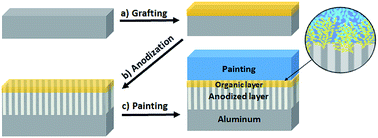Bifunctional coatings: coupling an organic adhesion promoter with an anticorrosion inorganic layer†
Abstract
In this work, a multifunctional non-toxic chromium free treatment is proposed. Hexavalent chromium, largely used for anticorrosion surface treatments of aluminum alloys in aeronautics, will soon be completely banned due to its high toxicity (European REACH regulation) and new solutions are required. Here, in a first step, a polymeric film was grafted at the aluminum surface by the surface induced reduction of a diazonium salt. In a second step, the grafted surface was submitted to an anodization treatment, forming a thick aluminum oxide layer protecting the underlying metal against corrosion. No change in the organic coating was detected after the second step of the process. This leads to a multilayer coating, which provides competitive results regarding both the adhesion of paint and corrosion protection.



 Please wait while we load your content...
Please wait while we load your content...